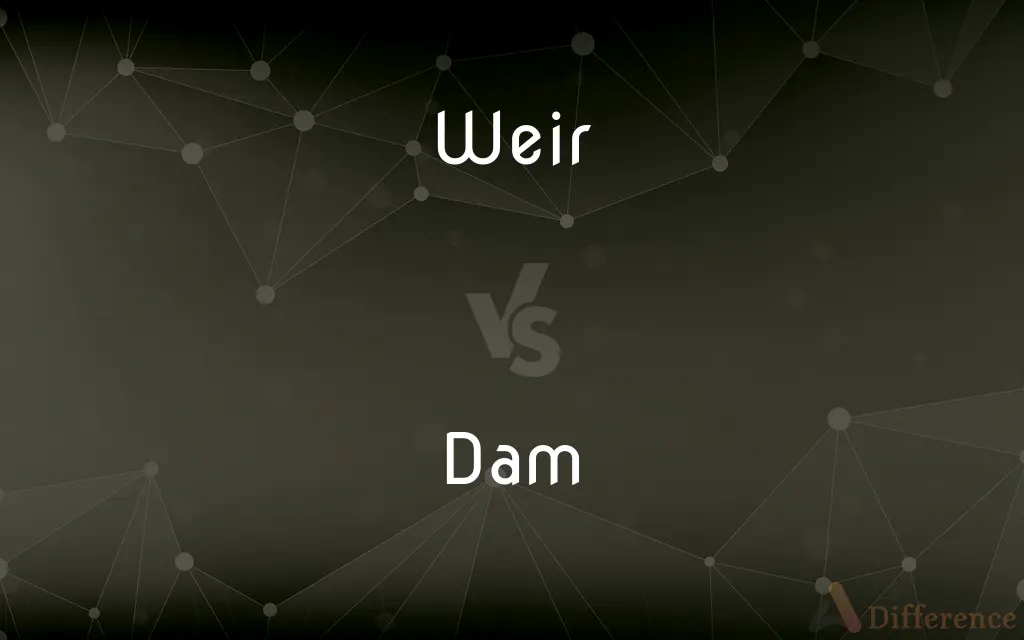Weir vs. Dam — What's the Difference?
By Maham Liaqat & Fiza Rafique — Updated on April 2, 2024
A weir is a barrier across a river to control flow, often allowing water to flow over its top, whereas a dam is a larger structure designed to store water in a reservoir.

Difference Between Weir and Dam
Table of Contents
ADVERTISEMENT
Key Differences
Weirs are typically constructed to alter a river's flow characteristics, mainly for purposes like measurement, irrigation, or prevention of flooding. On the other hand, dams are built to create reservoirs for water supply, hydroelectric power generation, or recreational uses.
While weirs are often lower in height, allowing water to flow over them, dams are usually taller structures designed to completely block a river's flow, storing vast amounts of water behind them. This fundamental difference in design and purpose affects their construction, location, and impact on the environment.
The materials used in constructing weirs can vary, from wood and stones for traditional weirs to more modern materials like concrete for both weirs and dams. However, the construction of dams often involves more complex engineering and significantly more resources due to their larger scale and the necessity to withstand greater forces.
In terms of environmental impact, weirs can change the aquatic habitat by altering water flow and temperature, potentially affecting fish migration. Dams, however, have a more pronounced impact, including disrupting ecosystems, displacing communities, and changing landscape patterns due to the creation of large reservoirs.
Both weirs and dams play crucial roles in water management but serve different specific functions. Weirs are used for diversion or to raise the water level for irrigation, whereas dams primarily focus on water storage and power generation, reflecting their respective scales and capabilities.
ADVERTISEMENT
Comparison Chart
Primary Purpose
Control and divert water flow.
Store water and generate hydroelectric power.
Design
Allows water to flow over its top.
Blocks and stores water completely.
Height
Generally lower.
Significantly taller.
Construction Material
Wood, stone, or concrete.
Primarily concrete and steel.
Environmental Impact
Alters flow and can affect fish migration.
Disrupts ecosystems and displaces communities.
Use
Irrigation, flood prevention, measurement.
Water supply, power generation, recreation.
Compare with Definitions
Weir
Water diversion.
A temporary weir was constructed to divert water towards the farmland.
Dam
Water storage facility.
The new dam will supply water to the entire region during dry spells.
Weir
Low barrier.
The wooden weir allows small fish to pass over it during migration.
Dam
Hydroelectric power source.
The dam's turbines generate electricity for thousands of homes.
Weir
Measurement tool.
Scientists use a calibrated weir to measure the stream's flow rate accurately.
Dam
Flood control structure.
The dam has gates that can be opened to release water gradually and prevent flooding.
Weir
Flow control structure.
The ancient weir across the creek helps in managing irrigation efficiently.
Dam
Recreational area.
The reservoir created by the dam is a popular spot for boating and fishing.
Weir
Level raising.
Installing a weir raised the river level, facilitating better water access for the village.
Dam
Environmental impact.
The construction of the dam has led to significant ecological changes in the area.
Weir
A weir or low head dam is a barrier across the width of a river that alters the flow characteristics of water and usually results in a change in the height of the river level. Weirs are also used to control the flow of water for outlets of lakes, ponds, and reservoirs.
Dam
A dam is a barrier that stops or restricts the flow of surface water or underground streams. Reservoirs created by dams not only suppress floods but also provide water for activities such as irrigation, human consumption, industrial use, aquaculture, and navigability.
Weir
A fence or wattle placed in a stream to catch or retain fish.
Dam
A barrier constructed to hold back water and raise its level, forming a reservoir used to generate electricity or as a water supply
The dam burst after torrential rain
The Hoover Dam
Weir
A dam placed across a river or canal to raise or divert the water, as for a millrace, or to regulate or measure the flow.
Dam
A rubber sheet used to keep saliva from the teeth during dental operations, or as a prophylactic device during cunnilingus and anilingus.
Weir
An adjustable dam placed across a river to regulate the flow of water downstream.
Dam
The female parent of an animal, especially a domestic mammal.
Weir
A fence placed across a river to catch fish.
Dam
Build a dam across (a river or lake)
The river was dammed to form Lake Powell
Weir
(obsolete) Seaweed.
Dam
A barrier constructed across a waterway to control the flow or raise the level of water.
Weir
A dam in a river to stop and raise the water, for the purpose of conducting it to a mill, forming a fish pond, or the like.
Dam
A body of water controlled by such a barrier.
Weir
A fence of stakes, brushwood, or the like, set in a stream, tideway, or inlet of the sea, for taking fish.
Dam
A barrier against the passage of liquid or loose material, as a rubber sheet used in dentistry to isolate one or more teeth from the rest of the mouth.
Weir
A long notch with a horizontal edge, as in the top of a vertical plate or plank, through which water flows, - used in measuring the quantity of flowing water.
Dam
A female parent of an animal, especially a domesticated mammal such as a horse.
Weir
A low dam built across a stream to raise its level or divert its flow
Dam
(Archaic) A mother.
Weir
A fence or wattle built across a stream to catch or retain fish
Dam
To hold back or confine by means of a dam.
Dam
To close up; obstruct
He tried to dam his grief.
Dam
A structure placed across a flowing body of water to stop the flow or part of the flow, generally for purposes such as retaining or diverting some of the water or retarding the release of accumulated water to avoid abrupt flooding.
A dam is often an essential source of water to farmers of hilly country.
Dam
The water reservoir resulting from placing such a structure.
Boats may only be used at places set aside for boating on the dam.
Dam
(dentistry) A device to prevent a tooth from getting wet during dental work, consisting of a rubber sheet held with a band.
Dam
A reservoir.
Dam
A firebrick wall, or a stone, which forms the front of the hearth of a blast furnace.
Dam
Female parent, mother, generally regarding breeding of animals.
Dam
A kind of crowned piece in the game of draughts.
Dam
(India) An obsolete Indian copper coin, equal to a fortieth of a rupee.
Dam
A former coin of Nepal, 128 of which were worth one mohar.
Dam
(transitive) To block the flow of water.
Dam
Damn.
Dam
Damn.
Dam
A female parent; - used of beasts, especially of quadrupeds; sometimes applied in contempt to a human mother.
Our sire and dam, now confined to horses, are a relic of this age (13th century) . . . .Dame is used of a hen; we now make a great difference between dame and dam.
The dam runs lowing up and down,Looking the way her harmless young one went.
Dam
A king or crowned piece in the game of draughts.
Dam
A barrier to prevent the flow of a liquid; esp., a bank of earth, or wall of any kind, as of masonry or wood, built across a water course, to confine and keep back flowing water.
Dam
A firebrick wall, or a stone, which forms the front of the hearth of a blast furnace.
Dam
To obstruct or restrain the flow of, by a dam; to confine by constructing a dam, as a stream of water; - generally used with in or up.
I'll have the current in this place dammed up.
A weight of earth that dams in the water.
Dam
To shut up; to stop up; to close; to restrain.
The strait pass was dammedWith dead men hurt behind, and cowards.
Dam
A barrier constructed to contain the flow of water or to keep out the sea
Dam
A metric unit of length equal to ten meters
Dam
Female parent of an animal especially domestic livestock
Dam
Obstruct with, or as if with, a dam;
Dam the gorges of the Yangtse River
Common Curiosities
Can weirs generate electricity like dams?
While weirs can be equipped with small-scale hydroelectric generators, dams are primarily used for large-scale hydroelectric power production.
How do dams contribute to flood control?
Dams can store excess water during heavy rains and release it gradually, reducing the risk of downstream flooding.
What is the main difference between a weir and a dam?
The main difference lies in their purpose and design: weirs control flow and allow water to pass over, while dams block and store water.
What materials are used to build a weir?
Materials can include wood, stone, and concrete, depending on the weir's size and purpose.
How do weirs affect river navigation?
Weirs can pose challenges to navigation but may include locks or bypass channels to allow for boat passage.
Why are weirs used in rivers?
Weirs are used for water management, including diversion, flow measurement, and sometimes for small-scale hydroelectric power.
How do dams affect local ecosystems?
Dams can significantly alter local ecosystems by disrupting wildlife habitats, blocking fish migration, and changing water quality and flow patterns.
Are all dams made of concrete?
While many dams are made of concrete due to its strength, some may also use earth, rockfill, or other materials depending on the design and purpose.
Can the construction of a weir affect fish migration?
Yes, weirs can obstruct fish migration, though some are designed with fish ladders to mitigate this impact.
What role do dams play in hydroelectric power?
Dams are crucial for hydroelectric power, using stored water to drive turbines and generate electricity.
Do all dams create reservoirs?
Most dams create reservoirs to store water for various uses, though the size of the reservoir can vary greatly.
What is a fish ladder?
A fish ladder is a structure that allows fish to navigate around barriers like dams and weirs during migration.
How do environmentalists view dams and weirs?
Environmentalists often express concerns about the impact of dams and weirs on ecosystems, advocating for careful planning and mitigation measures.
Can both weirs and dams be temporary?
While permanent structures are common, both weirs and dams can be designed as temporary solutions for specific purposes.
Are there alternatives to dams and weirs for water management?
Alternatives include water conservation, groundwater recharge, and the use of less intrusive diversion techniques, depending on the specific water management goals.
Share Your Discovery

Previous Comparison
Framework vs. Tool
Next Comparison
Suffix vs. TitleAuthor Spotlight
Written by
Maham LiaqatCo-written by
Fiza RafiqueFiza Rafique is a skilled content writer at AskDifference.com, where she meticulously refines and enhances written pieces. Drawing from her vast editorial expertise, Fiza ensures clarity, accuracy, and precision in every article. Passionate about language, she continually seeks to elevate the quality of content for readers worldwide.
















































